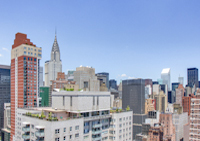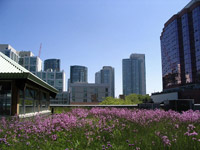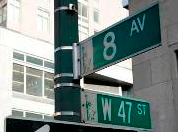For NYC dwellers on the hunt for an apartment, green residences might seem more of a nicety than a necessity. But by 2030 high-rise city real estate is going to get a whole lot greener, and hopefully a whole lot more affordable. A recent study has found that simple energy-conserving technology can save landlords bundles, and the statistics endorse New York City’s continued push for citywide environmental initiatives. To keep the city’s green-o-meter rising, new laws mandate many large buildings keep a public tab on their energy efficiency. The desired outcome is green new developments and retrofitted buildings. But what will the impact of all this paper shuffling be for renters, and does this look like a greener NYC or a pipe dream?
As we’ve noted before, citywide efforts to make buildings greener don’t need to be earth shattering. Recall the spread of white roofs that took off in the Lower East Side earlier this year. The simple technique to cool buildings reduces electrical and fueling costs and increases building efficiency by as much as 25%. But if adding green technology to existing buildings is is the easy road, why hasn't it been done before? “There is an almost universal lack of understanding of building energy usage,” said project manager Luke Falk of the New York State Energy Research and Development Authority to the New York Times. The effort to supply research to help developers understand returns on green retrofits was accomplished by the Deutsche Bank/Living Cities Building Energy Efficiency Data Report. And their findings were exactly the data needed to resolve the skepticism hampering the spread of green technologies.
The study found a 19 percent savings on fuel bills, and a 10 percent savings on electricity from in the 19,000 NYC retrofitted housing units they pooled. According to the NYTimes, this translates into $240 in fuel savings and $70 in electrical savings per apartment every year. Some retrofitting practices include installing energy-conserving technology like efficient boilers, high-quality windows and compact florescent light bulbs. Upgrading to Energy Star appliances and making tenants responsible for their own electrical bills can also save dough. Although the report conceded it would be hard to pinpoint the precise value of savings of the green renovations, experts are confident that energy efficiency renovations reduce buildings costs. And the city with its wealth of luxury rental real-estate has whole-heartedly bought in, which makes sense considering the growing interest in clean green living and green rental apartments.
$1 billion is expected to flow into retrofitting NYC multifamily buildings through the next decade, funds mostly drawn from federal stimulus money, city commitments and private initiatives. A push for retrofitted green housing may make the cost of environmentally-friendly renting less extravagant in the near future, and may turn the idea of lowering your carbon footprint from a financial luxury into financial common sense. Here at Luxury Rentals Manhattan, we believe NYC renters, report or no report, should not be afraid to demand green extras.





